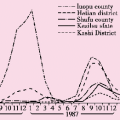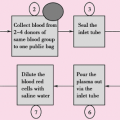Euproctis similes dermatitis, an epidemic in Shanghai in 1972
Outline
In July, 1972, an outbreak of dermatitis occurred in Shanghai with the unPrecedented high attack rate in the medical history. Field ePidemiological investigation was carried out to determine the cause of outbreak and mode of transmission by comParing the attack rates in different PoPulation and Places. Biological and Meteorological data were also collected In conclusion, the ‘Pathogen’ of the dermatitis was confirmed to be the ‘urticating hairs’ of the EuProctis similes (E. similies) larva habituating in the mulberry and PoPlar. The hot and windy weather acted as a media to amPlify the risk to this air-skin contact disease.
It was in July of 1972. An epidemic of dermatitis was observed in Shanghai which lasted for about three months. The dermatitis was more prevalent in suburb counties of Shanghai with varied severities. Most of the dermatitis cases were workers and farmers. There were also sporadic cases in downtown of the city. The epidemic of dermatitis was rare in the medical history in terms of the attack rate.
Patients with dermatitis had erythematous papules in some parts of body with unendurable itching. It was not cured until several days without medical treatment.
As reported, there were sporadic cases appearing at the beginning of July. The epidemic of dermatitis reached its peak during late July to the first ten days of August, trailed off with a smaller epidemic wave in late September and early October.
The epidemiological investigation
What caused the dermatitis? The etiological causes and risky factors remained unknown from the very outset. To find out the cause of the epidemic of dermatitis, an investigating team was organized composing of epidemiologists, clinicians, biologists and microbiologists, etc. On-site investigations were carried out; prevalence of the dermatitis were compared between people with different living surroundings. And the nature characteristics such as climates, insects and plants had also been considered.
The Huangpu River, which across Shanghai, geographically divides the city into western Shanghai and eastern Shanghai, i.e., downtown and suburb respectively. The investigation started in a dockyard in eastern Shanghai where a high prevalence of the dermatitis was reported. One thousand and eighty-eight workers were randomly sampled. The crude prevalence of dermatitis was 51.1% in total, 52.8% among male workers and 45.6% among female workers respectively. An interesting finding was that the prevalence were significantly lower in electric welders and gas-cutting workers than other workers for both males (χ2= 10.00, P<0.01) and females (χ2=5.14, P<0.02), whereas there was no significant difference in gender between these workers.
Further observations were given to identify the differences between the electric welders/gas-cutting workers and other workers. It was found that electric welders and gas-cutting workers wore thick uniform and face cover, providing the intensive protection allover the body. Based on this finding, the investigators considered the route of transmission of the dermatitis was by air-skin contact.
Similar findings were observed in several high prevalent suburb counties of Shanghai including Chuansha, Nanhui and Shanghai County. Patients under investigation mentioned that the dermatitis was associated with the wind. They were more likely to feel itching when it was windy. The idea came to the investigators that the prevalence of dermatitis deserved analysis with regard to the strength of wind. Firstly, two apartment buildings under similar strength of wind were selected; one in eastern Shanghai (Building A), and the other in western Shanghai of coastal area (Building B). In Building A, 85 of 192 inhabitants got dermatitis with an attack rate of 44.3%; and in Building B the dermatitis happened to 44 of 105 inhabitants with an attack rate of 41.9%. There was no statistically significant difference in dermatitis occurrence between these two buildings (P=0.50). Two more buildings (Building C and Building D) next to Building B but in the leeward side were investigated. The attack rates of dermatitis were respectively 15.6% and 9% in Building C and D, similar between, but both significantly lower than that in Building B (P<0.01).
To take into further consideration on wind, bus drivers were sampled as the study subjects. Bus No. 81 was running in the countryside eastern Shanghai under strong wind; and Bus No. 23 was rounding in downtown western Shanghai under weak wind. The attack rate of dermatitis was 48.3% among 89 drivers and conductors in Bus No.81, which was significantly higher than the 30.8% among the 104 drivers and conductors in Bus No.23 (χ2=6.21, P<0.01). One more study site, a windless alley in downtown was sampled to clarify the impact of wind. None dermatitis cases were detected among 69 inhabitants living in this alley. Furthermore, in a three-story building near to the alley, on the less windy ground floor, only one of the 41 people had dermatitis, while on the more windy 3rd floor, 13 of the 40 had been caught with the dermatitis, significantly different from the former (Yates corrected χ2=10.78, P<0.01).
Above findings strongly suggested that the strength of wind might influence the risk of dermatitis. But the conclusion merited the further investigation.
The investigation team went to the suburb Shanghai for further observations. In Nanhui County of Shanghai, two townships were visited, one is a fruit farm (Guoyuan) near the East Sea blown by strong wind, and the other is a township (Zhoupu) a little farther from the sea. One hundred and thirty-one fruit growers were sampled randomly in Guoyuan Township, and an dermatitis attack rate of 20.6% was reported. While in Zhoupu township where two neighboring villages with similar strength of wind were investigated. The attack rates in these two villages were significantly different, 73 of 116 (62.9%) and 24 of 98 (24.5%) respectively (χ2=31.92, P<0.001). It seemed that there were some other factors influencing the risk of dermatitis apart from wind.
The researchers went to another suburb county: Chuansha for more observations. A significant difference of attack rates of
dermatitis was found between another 2 selected neighboring villages with similar strength of wind. The attack rates were respectively 56.4% (31 of 55) and 17.6% (12 of 68), (χ2=9.16, P<0.01).
dermatitis was found between another 2 selected neighboring villages with similar strength of wind. The attack rates were respectively 56.4% (31 of 55) and 17.6% (12 of 68), (χ2=9.16, P<0.01).
Above findings showed that the high attack rate of dermatitis might not be specific to area blown by the strong wind; attack rates might be different even in the neighboring areas with similar strength of wind. Therefore, wind might act as the media of transmitting the pathogen of dermatitis and meanwhile play its role only when pathogen existed.
What caused the dermatitis? All sorts of assumption arose at the beginning of this epidemic, some of which were obviously tentative without further supporting evidences. For example, some felt that the pathogen lived in the water; other believed that the disease might be relevant to the waste gas discharged from a chemical factory; still others believed the dermatitis was caused by mildews. These assumptions were rejected by the investigation team from a series of interviewers and experiments. Meanwhile the plant hair (bristle) or pollen was assumed to cause the dermatitis. But this assumption was, discredited later by the researchers from biological department in Fudan University since the nettles or other dermatitis-causing plants with hairy and pollen were nowhere to find in the area with high prevalence of dermatitis.
From the clinical perspective, it could not be certain to say that the dermatitis was evoked entirely by bite and stimulation of the insects. A lot of considerations were taken into these subjects.
In dermatitis-prevalent areas, no evidence exhibited that the areas were ridden by those insects capable of biting and irritating skin (e.g. bug, lice, and mosquito). Meanwhile, there was no necessary association between the density of pests and strengthen of winds. The following attention was transferred to some sorts of insects such as mites. Quite a quantity of mites on the bed mats were collected and examined. It was found that these mat mites were not biters and they could not cause dermatitis in experimental conditions. Meanwhile, the existence of mites was not consistent with the occurrence of dermatitis. Therefore, the possibility was ruled out of mites’ pathogenesis in dermatitis.
Historically it is said that certain sorts of moths and their larva could cause dermatitis in human beings. Based on this knowledge, further investigation was carried out.
Stay updated, free articles. Join our Telegram channel

Full access? Get Clinical Tree







